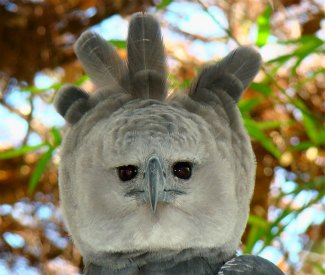Harpy Eagle - Harpia harpyja
By Michael Schamis, CC-BY-2.0, via Wikimedia Commons
Family: Accipitridae
Genus: Harpia
Species: H. harpyja
Harpy Eagles are the largest and most powerful eagles found in the Americas and they are some of the largest eagles in the world. They have dark gray, black, and white coloring, and live in the canopy of tropical and subtropical forest. They form a clade with genera Harpyopsis (New Guinea Harpy Eagle, Harpyopsis novaeguineae) and Morphnus (Crested Eagle, Morphnus guianensis).
Physical Description:
Harpy Eagles are dark gray from above with a relatively small head, long legs and tail, and short wings. The underside is white, except for a thick black band across the chest. The tail has three wide gray bands and is tipped with white, while the underwing and thighs are barred black and white. The head is light gray with a blackish crest that is raised when the bird feels threatened; it may also serve to focus sound, similar to an owl's facial disc. The beak is dark gray with a paler cere and the eyes are gray-brown. Feet and legs are light yellow—the talons are black, and can be up to 7 cm long.
Juveniles are white with a brown-gray back and have black-mottled wing coverts. The tail has 7-8 black bars. They also have a bushier crest than mature eagles. They reach full adult plumage after 4-5 years.
Their calls include a loud wail, whistle, and a quieter clucking sound, and juveniles emit a high-pitched scream when hungry. Listen to a Harpy Eagle.
They can live up to 25-35 years.
Size:
Length: 89-102 cm
Wingspan: 200 cm
Weight: Male: 4.0-4.8 kg. Female: 6.0-9.0 kg
Habitat and Distribution:
Harpy Eagles inhabit tropical and subtropical forest, in lowlands and foothills. They can survive in isolated patches of primary forest, selectively logged forest, and second-growth forest if there are some large trees. Their usual range is 0-800 m above sea level, but they have been recorded as high as 2,000 m, from 19°N to 27°S. They live within the tree canopy and are rarely seen flying over open spaces, though they can fly as fast as 80 km per hour.
They occur in southern Mexico and Central America, south to Colombia and Venezuela, and down through eastern Bolivia, Brazil, northeastern Argentina, and Paraguay. Harpy Eagles formerly occupied western Colombia and Ecuador but have been driven out of those regions. They are local or irruptive migrants; the distances juveniles disperse from breeding areas is unknown. There are an estimated 20,000-49,999 individuals over 7,600,000 km².
Diet and Hunting:
They eat mammals such as sloths, monkeys, agoutis, armadillos, and deer, in addition to birds—like guans, macaws and other parrots—and reptiles, including large lizards and snakes up to 5 cm in diameter.
They still-hunt from a position within the tree canopy or perch-hunt by flying from branch to branch, watching and listening for prey. Males take smaller prey than females, usually weighing only 0.5-2.3 kg, while females have been known to catch animals as large as 2.7-9.0 kg.
Reproduction:
Harpy Eagles do not have courtship displays, unlike some eagles, but similar to other forest raptors. Pairs are monogamous and mate for life. Rubbing bills, observed in these birds, is thought to be bonding behavior.
The nest is a large platform 120-150 cm wide and 60-120 cm deep. It is made out of sticks and placed in the fork of a large tree 25-55 m above the ground and lined with vegetation and animal fur. Both parents help build the nest and usually maintain several of them within their territory, though certain nests may be re-used if nesting is successful there. A clutch of 1-3, usually 2, eggs are laid and incubated by the female for 52-56 days. If there are two eggs, there is usually a span of a few days between each hatching and only the first chick will survive. Fledging takes 141-148 days, but young are dependent on their parents for at least 8-10 months after that. Consequently, adults only breed once every 2-3 years.
Parents are highly aggressive toward any potential threats to the nest, and they will even attack humans.
Conservation:
Harpia harpyja is currently listed as Near Threatened by BirdLife International. The population trend is declining due to habitat destruction, trophy shooting, and capture for the pet trade.
Taxonomy:
Genera Harpia, Harpyopsis (New Guinea Harpy Eagle, Harpyopsis novaeguineae), and Morphnus (Crested Eagle, Morphnus guianensis) have been found to form a clade based on molecular sequences of one nuclear intron and two mitochondrial genes.
Their common name, Harpy Eagle, comes from the harpies of Greek mythology—half-woman half-bird creatures that were thought to carry people off to the underworld for torture or punishment.
Other Names:
American Harpy Eagle, Harpyje pralesní (Czech), Harpy (Danish), Harpij (Dutch), Harpüia (Estonian), Harpyija (Finnish), Harpie féroce (French), Harpyie (German), Arpia americana (Italian), Ougiwashi (Japanese), Harpyørn (Norwegian), Harpia wielka (Polish), Aguila Arpía (Spanish), Harpyja (Swedish).
Video of a Harpy Eagle:
References:
Shaner, K. 2011. "Harpia harpyja" (On-line), Animal Diversity Web. Accessed December 17, 2011 at
http://animaldiversity.ummz.umich.edu/site/accounts/information/Harpia_harpyja.html.
http://avibase.bsc-eoc.org/species.jsp?lang=EN&avibaseid=4D324C9C5A1A7566
BirdLife International (2011) Species factsheet: Harpia harpyja. Downloaded from
http://www.birdlife.org on 17/12/2011.
http://www.blueplanetbiomes.org/harpy_eagle.htm
Global Raptor Information Network. 2011. Species account: Harpy Eagle Harpia harpyja. Downloaded from
http://www.globalraptors.org on 17 Dec. 2011
BirdLife International 2008. Harpia harpyja. In: IUCN 2011. IUCN Red List of Threatened Species. Version 2011.2.
www.iucnredlist.org. Downloaded on 17 December 2011.
Schulenberg, T. S.. 2009. Harpy Eagle (Harpia harpyja), Neotropical Birds Online (T. S. Schulenberg, Editor). Ithaca: Cornell Lab of Ornithology; retrieved
from Neotropical Birds Online: http://neotropical.birds.cornell.edu/portal/species/overview?p_p_spp=20613
http://www.pantheon.org/articles/h/harpies.html
http://www.peregrinefund.org/subsites/explore-raptors-2001/eagles/harpyeag.html
http://www.perunature.com/content/harpy-eagle-harpia-harpyja-amazon
Ferguson-Lees, James, and Christie, David A. Raptors of the World. Houghton Mifflin Company, 2001.
http://www.sandiegozoo.org/animalbytes/t-harpy_eagle.html


